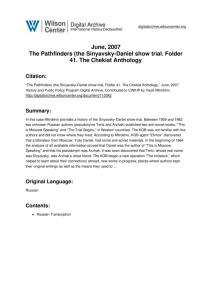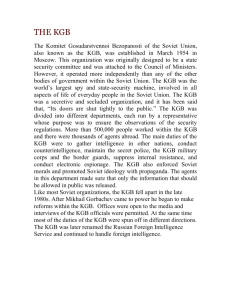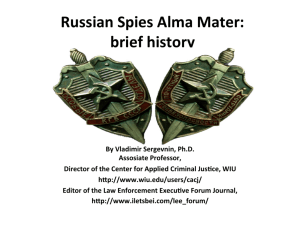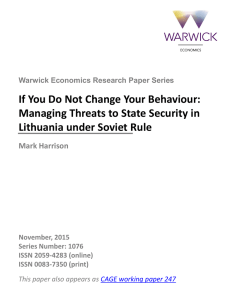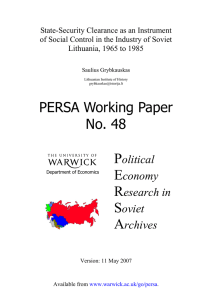P E R S
advertisement
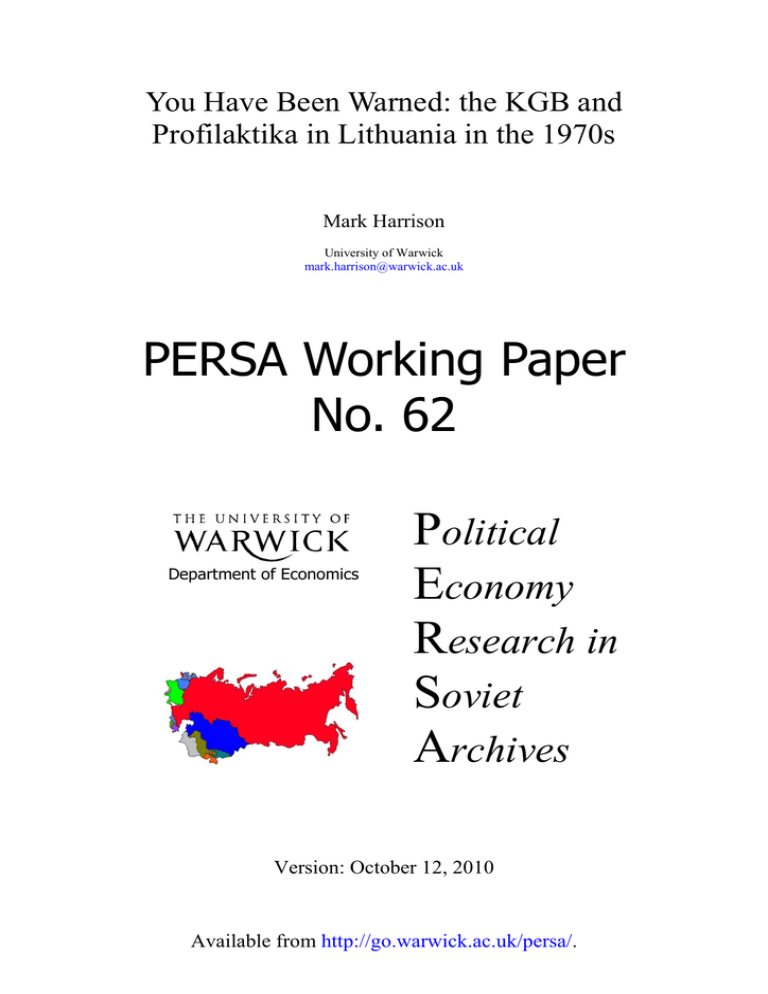
You Have Been Warned: the KGB and Profilaktika in Lithuania in the 1970s Mark Harrison University of Warwick mark.harrison@warwick.ac.uk PERSA Working Paper No. 62 Department of Economics Political Economy Research in Soviet Archives Version: October 12, 2010 Available from http://go.warwick.ac.uk/persa/. You Have Been Warned: the KGB and Profilaktika in Lithuania in the 1970s Mark Harrison* Department of Economics, University of Warwick Centre for Russian and East European Studies, University of Birmingham Hoover Institution on War, Revolution, and Peace, Stanford University Abstract This paper provides a preliminary view of the KGB’s work to prevent the spread of subversive ideas and behaviors in Soviet Lithuania in the 1970s, based on the technique of “profilaktika,” or preventive warnings. The paper considers the rationale, mode of operation, scope, and effectiveness of preventive warnings. The paper is short, because it is based on a first impression of extensive documentation. I have no intention to write a longer version. Rather, I hope the paper may attract other scholars to work on this fascinating and important subject. Keywords: Contagion, Dictatorship, Policing. JEL Codes: K42, N44, P26. * Mail: Department of Economics, University of Warwick, Coventry CV4 7AL, United Kingdom. Email: mark.harrison@warwick.ac.uk. I thank Paul Gregory and Leonora Soroka for advice; the University of Warwick for research leave; the University of Birmingham and the Hoover Institution for generous hospitality; and the staff of the Hoover Archive for excellent assistance. First draft: October 12, 2010. You Have Been Warned: the KGB and Profilaktika in Lithuania in the 1970s The KGB (Committee of State Security) was the “sword and shield” of the Bolshevik Revolution. When the KGB acted as the sword, it engaged in harassment and arrests, executions, assassinations, and “low intensity” military operations. We have a more vivid impression of the sword than of the shield. Yet for much of Soviet history KGB officers, especially in the provinces, spent more time acting as the shield. In the first section of this short paper, I introduce evidence from the files of the Lithuania KGB, now on microfilm in the Hoover Archive, concerning one of the KGB’s most important defensive instruments: profilaktika, or the system of preventive warnings. In the second section I use a single case to illustrate how this technique worked; in the third section I give examples of other cases to which it was commonly applied. The fourth section offers a preliminary evaluation, with a focus on a time when it clearly failed. The conclusion relates history to the present day. Shield versus Sword The files of the Lithuania KGB show both shield and sword at work. In the first years after World War II, Lithuania was an occupied country. KGB records from this time tell of armed nationalist uprisings and Soviet counterinsurgency.1 Gradually, Lithuania became more peaceful, and the sword largely gave way to the shield. When acting as the shield of the Soviet state, the Lithuania KGB still had plenty to do. Although increasingly quiet, Lithuania was never “normal.” Because of its history of nationalism, strong Roman Catholic congregation, large emigration, open coast, and land border with Poland, the KGB continued to regard Lithuania as a frontline theatre of the Cold War. What did the KGB do when it was shielding the Soviet state? In Lithuania, KGB resources were spent on surveillance, information gathering, and analysis. The information gathered was used in many ways, but one important application was to “profilaktika.” 1 George Reklaitis, “Cold War Lithuania: National Armed Resistance and Soviet Counter-Insurgency.” The Carl Beck Papers in Russian & East European Studies, no. 1806 (University of Pittsburgh, Centre for Russian and East European Studies 2007). 2 The word profilaktika translates directly as “prophylaxis” or “prevention.” In medical science prophylaxis means the prevention of disease. Soviet rulers correctly believed that their power was stabilized by mass conformity to a fixed set of “healthy” ideas and behaviors. The KGB saw oppositional ideas and behaviors as a disease that could be spread from person to person through contagion. They developed the technique of preventive warnings to isolate “unhealthy” expressions and prevent them from spreading. A contagion model of the spread of political ideas and national and cultural identities has some foundation in behavioral science. Human beings copy each other from birth. Examples around us powerfully influence how we dress, whether or not we use recreational drugs, the importance we place on the rule of law, whom we have sex with and why, how many children we have, which stocks we buy, which churches we attend, who gets our votes, and whether or not we attend political rallies.2 This makes it good sense for repressive regimes both to stay alert for “bad” examples, exemplified by dedicated enemies or traitors, and to watch carefully the wider circles of those who do not intend to be or follow enemies, but whose behavior can be changed by the infectious example of others. Profilaktika was not intended to deal with highly motivated dissidents or nationalists. The Soviet rulers regarded these as beyond curative treatment, and victimized, exiled, imprisoned, or shot them. Preventive warnings were intended to help previously “healthy” people who were at risk of being drawn away from the path of conformity. If left untreated, these people might become followers of enemies or become enemies themselves in the future. Timely intervention could still save them. They were suitable cases for treatment. This was a clear change from Stalin’s time, when the sword had priority over the shield. In the 1930s, Stalin developed the idea that many people were “unconscious enemies” who were likely to betray the state if put under sufficient pressure. Stalin’s treatment of choice was preventive arrest, imprisonment, or execution.3 Compared to this, preventive warnings were relatively humane. 2 This is not the place for a survey. In economics; one of the most highly cited works in this field is by Abhijit V. Banerjee, “A Simple Model of Herd Behavior,” Quarterly Journal of Economics 107:3 (1992), pp. 797-817. 3 Oleg Khlevniuk, “The Objectives of the Great Terror, 1937-38,” pp. 167168, in Soviet History, 1917-1953: Essays in Honour of R.W. Davies, edited by J.M. Cooper, Maureen Perrie, and E.A. Rees (New York, NY: St Martin’s Press 1995). 3 How did profilaktika work? On October 18, 1978, 34-year old Algirdas Aulas came to the KGB building in Vilnius for interview. A section head in the Venta radioelectronics design bureau, and a candidate for party membership, Aulas was cleared for access to “top secret” documents. He had an unblemished record – until now. An informer had reported Aulas for “telling anti-Soviet jokes, denigrating Soviet society and party and government leaders, belittling the role of the party and its youth league, and continually praising the American way of life.” Other informers had been put onto the case; these had confirmed the allegations and exposed at least one more like minded person. To guard the informers’ identity, the KGB had also secured formal reports from Aulas’s past and present colleagues. Aulas was interviewed by three officers.4 They told him they wanted to discuss “the causes of his inappropriate behavior in the collective, expressed in the dissemination of politically harmful propositions that denigrate our Soviet actuality.” At first, the report continues, “Aulas behaved mistrustfully and insincerely, and tried to show that he is not tolerating ideologically incorrect and harmful judgments. But, after he was provided with the concrete facts of his unhealthy propositions, he admitted that amongst his circle he actually did sometimes repeat jokes, without hostile intentions, and tolerate other incorrect propositions.” At this point Aulas offered a plea in mitigation. He blamed his lack of political understanding, and his inexperience and lack of preparation as a section chief. By joking about the party, he was aiming “just to entertain people so that their work would be worthy of the name. Comparisons with the USA served only as a criterion for evaluation of work. After the conversation he understood that in making comparisons it is necessary to consider well so that everyone will understand it properly.” At the end, Aulas “was warned of the unacceptability of similar facts in the future.” In response, he promised to change his behavior. The KGB passed this information to his workplace and neighborhood party committees. Given his promises, the interviewers recommended not to keep 4 Lietuvos ypatingasis archyvas (Lithuanian Special Archive), Lietuvos SSR Valstybės Saugumo Komitetas (Lithuanian Soviet Socialist Republic, Committee of State Security) at the Hoover Institution, selected records, 1940-1985, K-1/3/753, folios 74-76 (“Spravka o provedennoi profilaktika Aulasa Al’girdasa Antanovicha …,” signed by Lithuania KGB second administration third section chief, Grivechkin, first division chief Kazakov, and senior operative commissioner Iuriavichius, November 1978). 4 him under surveillance. But this recommendation was countermanded by their superior officer: “Organize surveillance for a period of one year.” There was no single template for profilaktika, but this was a fairly common pattern. All cases were carefully prepared, and reports of the KGB informer network were critical to the preparation. It was common for the subject to deny the allegations at first, and then to back down when all the evidence was presented. Surveillance was sometimes, but not always, maintained for a while after the interview. It is evident that the interview could be life changing. There was a seismic shift in the subject’s relationship with authority – and with friends, colleagues, and others around them. The subject was made to understand that the KGB knew everything about them. The KGB could only know everything if those closest to the subject were informers. Devastated and isolated, the subject nearly always took the only option on offer, the path of repentance. At the end of this psychological demolition, it was not uncommon that the subject thanked the KGB officers for their advice. What else did profilaktika cover? The KGB issued preventive warnings in many cases that do not look political at first sight. A large number, the largest single category in some years, involved young Lithuanian women who were looking for a good time, and found it by going down to the port of Klaipėda. Foreign sailors were continually in and out of the port, handling western currency and goods. These women found themselves on the edge of petty currency violations, low level black marketing, and casual prostitution. The KGB aimed to pick them up and warn them off, sometimes singly, sometimes in groups. The point of this was not to control petty crime or prostitution as such, however; what the KGB cared about was the women’s contact with foreigners. A similar stream of cases was provided by Lithuanian sailors who returned from the West with goods and currency. These gave them entry tickets into the same underworld of petty criminality and amoral behavior. In such cases the KGB aimed to impose a cultural and moral quarantine, stopping the spread of “unhealthy” Western-style values at the border. For similar reasons, the KGB also tried to control the behavior of Soviet citizens abroad. No one was allowed a passport to leave the country without careful, intrusive checks into their political record and reliability. Abroad, Soviet citizens had to conform to fixed rules of behavior. These included staying with the group and following group leaders’ instructions. Those that went off on their own, had unauthorized contacts with foreigners, or resold foreign goods or currency on their return, were reported, called in, and warned. 5 Many cases, like that of Algirdas Aulas, were of a more political character. The KGB was particularly interested in anyone that expressed nostalgia for “bourgeois Lithuania” (i.e. the independent state that had existed from 1918 to 1940), was indiscreet in letters to relatives abroad, or denigrated Soviet leaders or the Soviet way of life. Young people were a special problem. While some just wanted more fun than could be found in official youth clubs, others developed romantic feelings about political freedom and national identity. The KGB was continually treading on the heels of groups that discussed independent Lithuania, read nationalist poetry, or planned escapades involving leaflets and slogans. These were often students. The 1960s and 1970s were a time of student revolution; if in Paris or Prague, why not in Vilnius? Some students were children of the Lithuanian party elite; the party wanted them to aspire to lead Soviet, not independent Lithuania. Sometimes they needed to be taught a lesson, firmly but carefully, so that they would return to the path of “healthy” ideas and behavior. Most preventive warnings were conducted in the privacy of the KGB offices, but another version of the drama was enacted in semi-public meetings in schools and colleges, offices, or neighborhoods. This was sometimes applied to groups, for example student networks embarking on nationalist activity or groups of girls that were going down to the ports. The emotional beating was administered not by KGB officers, but by work colleagues, teachers, fellow students, and community leaders. How well did profilaktika work? Preventive warnings seem to have been very effective. In eight years of the late 1960s and early 1970s, according to KGB figures, more than 120,000 people were “treated” by profilaktika across the entire Soviet Union; only 150 were subsequently taken to court for an actual offense.5 There is no way of auditing such figures, but a 10-fold or even 50-fold underestimate would still represent a recidivism rate that western penal systems can only dream about. On occasion, the system failed. In Lithuania in 1972, for example, some of the KGB’s worst fears were realized. In March, a petition for greater religious freedom that had circulated within the church reached the West, with an astonishing total of 17,000 signatures. Things got worse in May: a student, Romas Kalanta, burned himself to death in front of the Kaunas Musical Theater, where the incorporation of Lithuania into the Soviet Union was 5 Rudol'f Pikhoia, Sovetskii Soiuz: istoriia vlasti, 1945–1991 (Moscow: RAGS, 1998), pp. 365-366. 6 announced in 1940.6 According to rumor, he belonged to a nationalist student network, and the members had drawn lots to decide which should do this. The KGB’s attempts to preempt funeral demonstrations only inflamed things and there were two days of public disorder. This was exactly what KGB surveillance and prevention were supposed to avoid. After the event, the KGB had to deal with hundreds of people who had taken part in demonstrations. Some were demoted at work or taken into the Soviet Army. But the main emphasis fell on putting several hundred people through the process of profilaktika. A report notes: “A number were punished administratively. Warning conversations were held with the majority by the city KGB and internal affairs (i.e. police) agencies.”7 In other words, the government acted on the belief that most of those that took part in the troubles could be put back on the right path. Another report notes that most of those receiving warnings were under 25 years, including many members of the communist youth league. In nearly all cases, it was said, the warning was enough to change their behavior.8 “Such measures, as a rule, have positively influenced not only those preventively warned but also those around them, and have helped to uncover the factors giving rise to unwanted manifestations, to eliminate defects, and to improve educational work in the college and workplace collectives of those being warned.” After this time, Lithuania became quiet again. The KGB returned to routine operations, but continued to watch Lithuanians warily, especially after the rise of Solidarity in neighboring Poland. This risk assessment was essentially correct, because a mass opposition suddenly appeared again in 1988, spread widely among communist party and youth league members, and led directly to national independence in 1990. 6 Thomas Remeikis, “Self-Immolation and National Protest in Lithuania,” and “Eyewitness Report of Demonstrations in Kaunas, Lithuania, Following the Self-Immolation of Romas Kalanta, May 18-19, 1972,” Lituanus: Lithuanian Quarterly Journal of Arts and Sciences 18:4 (1972), pp. 58-69. 7 Hoover/LYA, K-1/3/703, 170-174 (KGB Kaunas city chief Bagdonas and third division chief Trukhachev, “Spravka o merakh po vypolneniiu postanovleniia TsK KP Litvy ot 30 maia 1972 goda …,” August 17, 1973). 8 Hoover/LYA, K-1/3/717, 123-130 (Lithuania KGB fifth department deputy chief Stalauskas, second administration third department deputy chief Grishechkin, and senior inspector under the Lithuania KGB chairman Malakhov, “Spravka o sostoianii profilakticheskoi raboty v KGB pri Sovete Ministrov Litovskoi SSR i merakh po eë sovershenstvovaniiu,” October 17, 1974). 7 Conclusion Preventive warnings were the shield of the Soviet state, rather than the sword. Their hidden foundation was the KGB agent and informer network. This network carried out the surveillance of society and sent signals of individual behaviour to the KGB to which the system of profilaktika could respond. It made viable, at least for several decades, a police state based on surveillance and warnings rather than mass terror. The stability of this system depended on ceaseless vigilance, however. If the KGB let its shield down, society could erupt at any moment. On October 8, 2010, the Russian Parliament gave the first reading to a bill that authorizes new powers for the FSB (Federal Security Service), the successor to the KGB. It allows the FSB to issue binding warnings to citizens suspected of creating conditions, through negligence, passivity, or incitement, in which crimes might be committed or facilitated. A warning that is ignored can be followed by an unspecified penalty, even though the actions that led to the warning may not be offenses in themselves. This draft law restores the legal basis of profilaktika. Since Vladimir Putin first became president of Russia in 2000, successive administrations have aimed to stabilize the state’s “power vertical.” Reinstating preventive warnings is part of this process. These warnings rely on surveillance and informers for their effectiveness, so the law implies that the population is being taken back under close, intrusive observation. If this works as it should, Russian politics will return to its traditional pattern of long periods without change, suddenly and unpredictably broken when infectious ideas suddenly take hold and people rise up.
